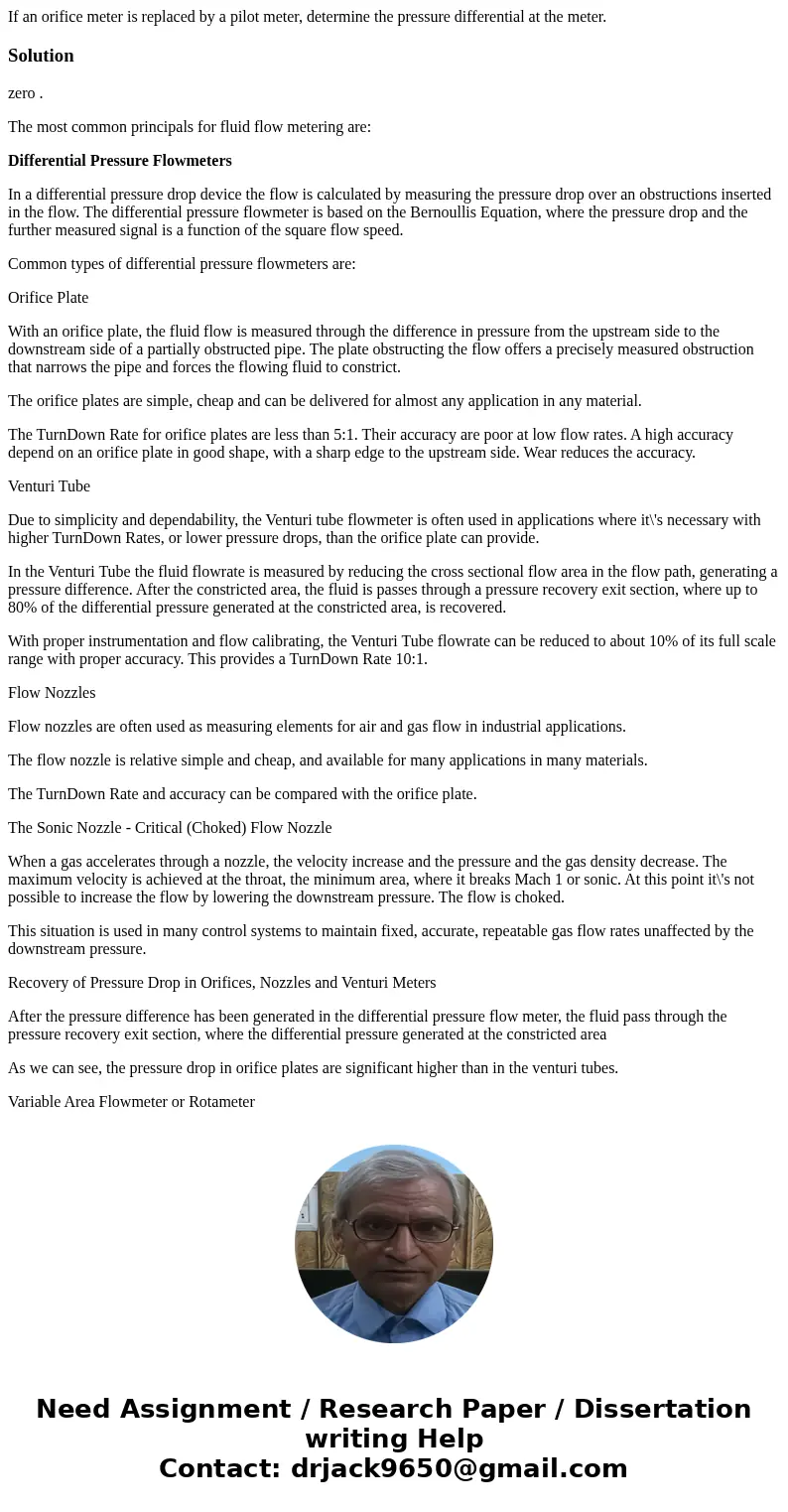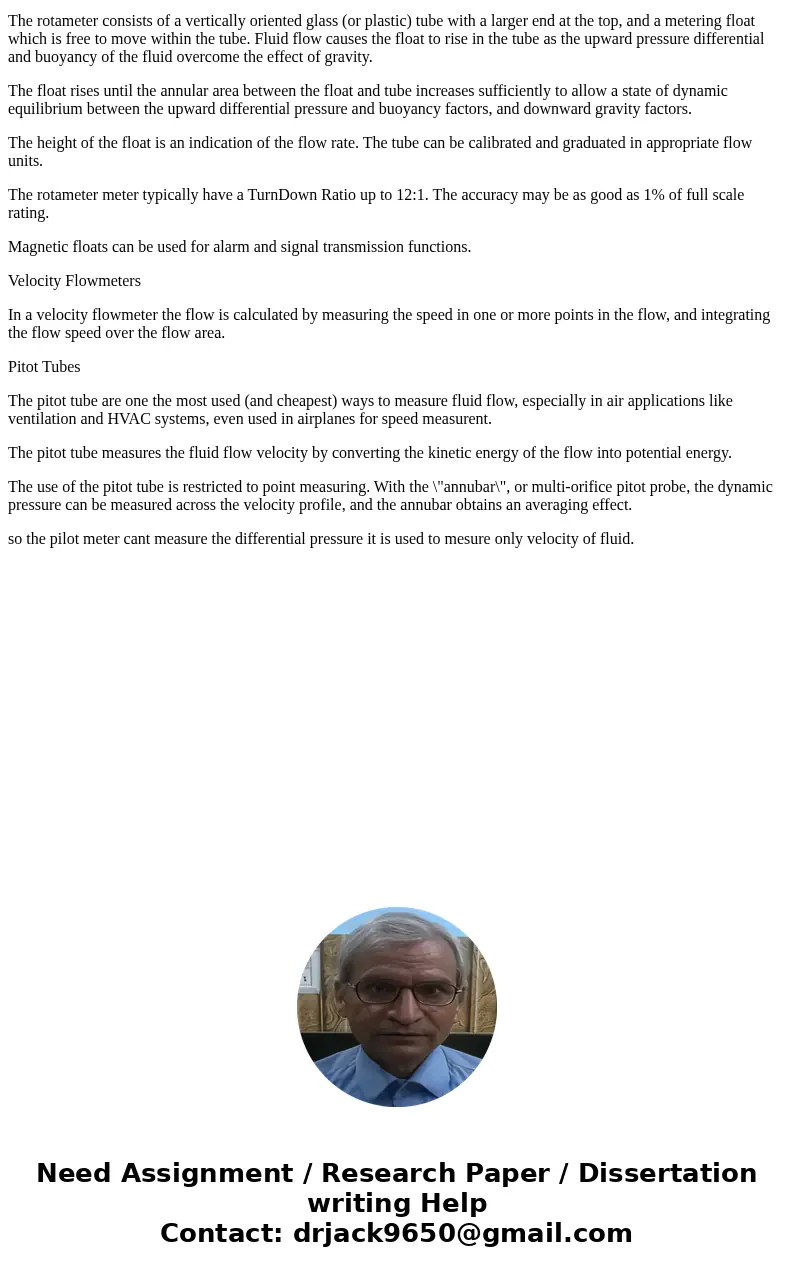If an orifice meter is replaced by a pilot meter determine t
If an orifice meter is replaced by a pilot meter, determine the pressure differential at the meter.
Solution
zero .
The most common principals for fluid flow metering are:
Differential Pressure Flowmeters
In a differential pressure drop device the flow is calculated by measuring the pressure drop over an obstructions inserted in the flow. The differential pressure flowmeter is based on the Bernoullis Equation, where the pressure drop and the further measured signal is a function of the square flow speed.
Common types of differential pressure flowmeters are:
Orifice Plate
With an orifice plate, the fluid flow is measured through the difference in pressure from the upstream side to the downstream side of a partially obstructed pipe. The plate obstructing the flow offers a precisely measured obstruction that narrows the pipe and forces the flowing fluid to constrict.
The orifice plates are simple, cheap and can be delivered for almost any application in any material.
The TurnDown Rate for orifice plates are less than 5:1. Their accuracy are poor at low flow rates. A high accuracy depend on an orifice plate in good shape, with a sharp edge to the upstream side. Wear reduces the accuracy.
Venturi Tube
Due to simplicity and dependability, the Venturi tube flowmeter is often used in applications where it\'s necessary with higher TurnDown Rates, or lower pressure drops, than the orifice plate can provide.
In the Venturi Tube the fluid flowrate is measured by reducing the cross sectional flow area in the flow path, generating a pressure difference. After the constricted area, the fluid is passes through a pressure recovery exit section, where up to 80% of the differential pressure generated at the constricted area, is recovered.
With proper instrumentation and flow calibrating, the Venturi Tube flowrate can be reduced to about 10% of its full scale range with proper accuracy. This provides a TurnDown Rate 10:1.
Flow Nozzles
Flow nozzles are often used as measuring elements for air and gas flow in industrial applications.
The flow nozzle is relative simple and cheap, and available for many applications in many materials.
The TurnDown Rate and accuracy can be compared with the orifice plate.
The Sonic Nozzle - Critical (Choked) Flow Nozzle
When a gas accelerates through a nozzle, the velocity increase and the pressure and the gas density decrease. The maximum velocity is achieved at the throat, the minimum area, where it breaks Mach 1 or sonic. At this point it\'s not possible to increase the flow by lowering the downstream pressure. The flow is choked.
This situation is used in many control systems to maintain fixed, accurate, repeatable gas flow rates unaffected by the downstream pressure.
Recovery of Pressure Drop in Orifices, Nozzles and Venturi Meters
After the pressure difference has been generated in the differential pressure flow meter, the fluid pass through the pressure recovery exit section, where the differential pressure generated at the constricted area
As we can see, the pressure drop in orifice plates are significant higher than in the venturi tubes.
Variable Area Flowmeter or Rotameter
The rotameter consists of a vertically oriented glass (or plastic) tube with a larger end at the top, and a metering float which is free to move within the tube. Fluid flow causes the float to rise in the tube as the upward pressure differential and buoyancy of the fluid overcome the effect of gravity.
The float rises until the annular area between the float and tube increases sufficiently to allow a state of dynamic equilibrium between the upward differential pressure and buoyancy factors, and downward gravity factors.
The height of the float is an indication of the flow rate. The tube can be calibrated and graduated in appropriate flow units.
The rotameter meter typically have a TurnDown Ratio up to 12:1. The accuracy may be as good as 1% of full scale rating.
Magnetic floats can be used for alarm and signal transmission functions.
Velocity Flowmeters
In a velocity flowmeter the flow is calculated by measuring the speed in one or more points in the flow, and integrating the flow speed over the flow area.
Pitot Tubes
The pitot tube are one the most used (and cheapest) ways to measure fluid flow, especially in air applications like ventilation and HVAC systems, even used in airplanes for speed measurent.
The pitot tube measures the fluid flow velocity by converting the kinetic energy of the flow into potential energy.
The use of the pitot tube is restricted to point measuring. With the \"annubar\", or multi-orifice pitot probe, the dynamic pressure can be measured across the velocity profile, and the annubar obtains an averaging effect.
so the pilot meter cant measure the differential pressure it is used to mesure only velocity of fluid.


 Homework Sourse
Homework Sourse